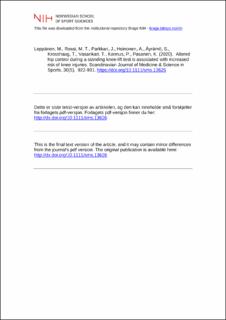| dc.contributor.author | Leppänen, Mari | |
| dc.contributor.author | Rossi, Marco T. | |
| dc.contributor.author | Parkkari, Jari | |
| dc.contributor.author | Heinonen, Ari | |
| dc.contributor.author | Äyrämö, Sami | |
| dc.contributor.author | Krosshaug, Tron | |
| dc.contributor.author | Vasankari, Tommi | |
| dc.contributor.author | Kannus, Pekka | |
| dc.contributor.author | Pasanen, Kati | |
| dc.date.accessioned | 2021-02-02T08:54:26Z | |
| dc.date.available | 2021-02-02T08:54:26Z | |
| dc.date.created | 2020-06-08T14:51:42Z | |
| dc.date.issued | 2020 | |
| dc.identifier.citation | Scandinavian Journal of Medicine & Science in Sports. 2020, 30(5), 922-931. | en_US |
| dc.identifier.issn | 0905-7188 | |
| dc.identifier.uri | https://hdl.handle.net/11250/2725718 | |
| dc.description | I Brage finner du siste tekst-versjon av artikkelen, og den kan inneholde ubetydelige forskjeller fra forlagets pdf-versjon. Forlagets pdf-versjon finner du på onlinelibrary.wiley.com / In Brage you'll find the final text version of the article, and it may contain insignificant differences from the journal's pdf version. The definitive version is available at onlinelibrary.wiley.com | en_US |
| dc.description.abstract | A few prospective studies have investigated hip and pelvic control as a risk factor for lower extremity (LE) injuries. The purpose of this study was to investigate whether deficits in hip and lumbopelvic control during standing knee‐lift test are associated with increased risk of acute knee and LE injuries in youth team sports. At baseline, 258 basketball and floorball players (aged 12‐21 years) participated in a standing knee‐lift test using 3‐dimensional motion analysis. Two trials per leg were recorded from each participant. Peak sagittal plane pelvic tilt and frontal plane pelvic drop/hike were measured. Both continuous and categorical variables were analyzed. New non‐contact LE injuries, and match and training exposure, were recorded for 12 months. Seventy acute LE injuries were registered. Of these, 17 were knee injuries (eight ACL ruptures) and 35 ankle injuries. Risk factor analyses showed that increased contralateral pelvic hike was significantly associated with knee injury risk when using categorical variable (HR for high vs low group 4.07; 95% CI 1.32‐12.6). Furthermore, significant association was found between high lateral pelvic hike angles and ACL injury risk in female players (HR for high vs low group 9.10; 95% CI 1.10‐75.2). Poor combined sensitivity and specificity of the test was observed. In conclusion, increased contralateral pelvic hike is associated with non‐contact knee injury risk among young team sport players and non‐contact ACL injuries among female players. More research to determine the role of pelvic control as a risk factor for knee injuries is needed. | en_US |
| dc.language.iso | eng | en_US |
| dc.subject | anterior cruciate ligament | en_US |
| dc.subject | biomechanics | en_US |
| dc.subject | knee injuries | en_US |
| dc.subject | screening | en_US |
| dc.subject | team sports | en_US |
| dc.title | Altered hip control during a standing knee‐lift test is associated with increased risk of knee injuries | en_US |
| dc.type | Peer reviewed | en_US |
| dc.type | Journal article | en_US |
| dc.description.version | acceptedVersion | en_US |
| dc.source.pagenumber | 922-931 | en_US |
| dc.source.volume | 30 | en_US |
| dc.source.journal | Scandinavian Journal of Medicine & Science in Sports | en_US |
| dc.source.issue | 5 | en_US |
| dc.identifier.doi | 10.1111/sms.13626 | |
| dc.identifier.cristin | 1814405 | |
| dc.description.localcode | Institutt for idrettsmedisinske fag / Department of Sports Medicine | en_US |
| cristin.ispublished | true | |
| cristin.fulltext | postprint | |
| cristin.qualitycode | 2 | |
